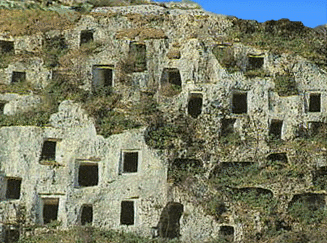...Best of Sicily presents... Best of Sicily Magazine. ... Dedicated to Sicilian art, culture, history, people, places and all things Sicilian. |
by Carlo Trabia | |||
Magazine Index Best of Sicily Arts & Culture Fashion Food & Wine History & Society About Us Travel Faqs Contact Map of Sicily
|
Who built Pantalica? What do we know of the people who once lived here? They were probably part of a neolithic civilisation which later, with the early use of metals, came to be identified with the Sicanians. When the Sicels (or Sikels) arrived, they displaced the Sicanians, who had at one time inhabited most of Sicily. Yet the "Proto Sicanian" influence may have spread as far as Malta. By 800 BC these communities flourished westward in the area of the Sicanian Mountains which bear their name. Cefalù's Temple of Diana was built by Sicanians. One of the earliest structures at Pantalica, the Anaktoron, is a megalithic building which may have been influenced by Mycenaean architecture. We know that there were Mycenaean settlements along Sicily's Ionian coast, and this suggests close contact between them and the native Sicanians. Though Pantalica itself is a cemetery, there were settlements nearby. Not many certainties can be deduced about the ancient people of the Pantalica area. Other Mediterranean cultures (for example the Egyptians) were far more advanced. As so often happens in historical studies, what we know is eclipsed by what we do not know. There are a few necropoli carved in circular forms, and in fact the tombs of Pantalica are linked to two periods of exceptional development. Pantalica is a very natural setting for these tombs. The gorge formed by the Anapo and Calcinara is a a focal point of natural beauty, both flora and fauna. Coming from Ferla the visitor benefits from a more gradual path. Entering from Sortino, the descent is a more demanding hike. Sicily boasts a similar site not too far from Pantalica; Cavagrande Cassibile is a splendid canyon and nature reserve where a small number of necropoli are carved into the limestone cliffs. About the Author: Carlo Trabia is an architect who lectures on architectural history. | ||
Top of Page |
 Pantalica is found near the
Anapo river and the Ferla and Sortino localities in a canyon not too far
from
Pantalica is found near the
Anapo river and the Ferla and Sortino localities in a canyon not too far
from